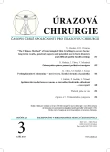Pelvic Osteosynthesis using computer guided navigation
Authors:
Roman Madeja; Leopold Pleva; Vladimír Ječmínek
Authors‘ workplace:
Trauma Centre University Hospital Ostrava and Fakulty of Medicine University of Ostrava
; Traumatologické centrum FN Ostrava a Lékařská fakulta OU v Ostravě
Published in:
Úraz chir. 23., 2015, č.3
Overview
Objective:
The authors report about their experience using computer guided navigation in pelvic/acetabular osteosynthesis regarding duration of surgery and peri-operative radiation doses.
Materials and methods:
A total of 29 osteosyntheses were performed using computer guided navigation of the sacroiliac joint (21) and acetabulum (8). For fixation cannulated screws were used. The followed parameters were duration of surgery, radiation dose as seen on the image-intensifier, related to the number of inserted screws.
Results:
The graphs show a decrease in duration of surgery and radiation dose corresponding with the number of surgeries performed. We observed one infection. There were no mal-positions of the inserted screws or damage to neurovascular structures seen.
Conclusion:
The use of computer guided navigation in screw fixation of the pelvic area can significantly reduce the perioperative radiation load and shorten duration of surgery.
Key words:
Computer navigation device, osteosynthesis pelvis, X- ray radiation.
Sources
1. BRIEM, D., RUEGER, JM., BEGEMANN, PG. et al. Computer-assisted screw placement into the posterior pelvic ring: assessment of different navigated procedures in a cadaver trial. Unfallchirurg. 2006, 109, 640–646, ISSN 0177–5537.
2. FOLEY, KT., SIMON, DA., RAMPERSAUD, YR. Virtual fluoroscopy: computer-assisted fluoroscopic navigation. Spine. 2001, 26, 347–351. ISSN 0362–2436.
3. GEBHARD, FT., KRAUS, MD., SCHNEIDER, E. et al. Does computer-assis-ted spine surgery reduce intraoperative radiation doses? Spine. 2006, 31, 2024–2027. ISSN 0362–2436.
4. GRAS, F., MARINTSCHEV, I., MENDLER, F. et al. 2D-fluoroscopic navigated screw osteosynthesis of acetabular fractures: A preliminary report. Orthop Unffal. 2008, 146, 231–239, ISSN 1864–6697.
5. CHMELOVÁ, J., DŽUPA, V., PLEVA, L. Role zobrazovacích metod v diagnostice poranění pánve. Acta Chir Orthop Traumatol Cech. 2008, 75, 93–98, ISSN 0001–5415.
6. PAVELKA, T., DŽUPA, V., RYŠAVÝ, M. et al. Poranění pánevního kruhu. Acta Chir Orthop Traumatol Cech. 2006, 73, 405–413, ISSN 0001–5415.
7. RUAN, Z., LUO, CF., ZENG, BF. et al. Percutaneous screw fixation for the acetabular fracture with quadrilateral plate involved by three-dimensional fluoroscopy navigation: surgical technique. Injury. 2012, 43, 517–521. ISSN 0020–1383.
8. SOUKUP, B. Osteosyntéza sakroilického kloubu u nestabilních zlomenin pánevního kruhu. Acta Chir Orthop Traumatol Cech. 1999, 66, 146–151, ISSN 0001–5415.
9. TALLER, S., LUKÁŠ, R., ŠRÁM, J. et al. Urgentní ošetření komplexních zlomenin pánve. Rozhl Chir. 2005, 84, 83–87. ISSN 0035–9351.
10. TILE, M. Acute pelvic fractures: I. Causation and classification. J Am Acad Orthop Surg. 1996, 4, 143-151. ISSN 1067-151X.
Labels
Surgery Traumatology Trauma surgeryArticle was published in
Trauma Surgery

2015 Issue 3
Most read in this issue
- Ipsilateral posterior shoulder dislocation and sternoclavicular dislocation – case report
- Peri-implant fractures - new chalenge. Short review and case history
- Pelvic Osteosynthesis using computer guided navigation
- “The Chinese Method” of Intermingled Skin Grafting in severe burns: long term results, genetical aspects and potential use in burn disasters and difficult public health settings
